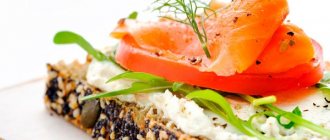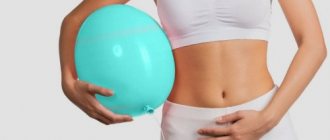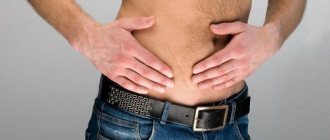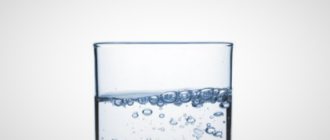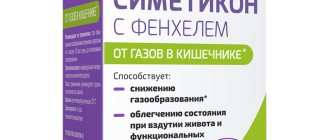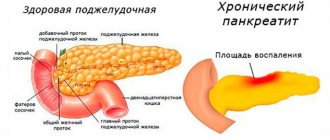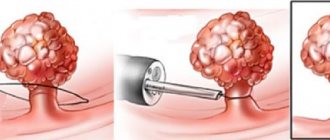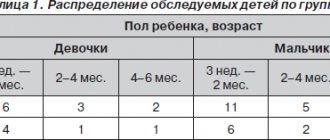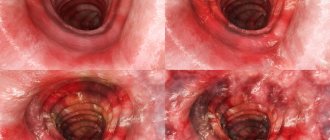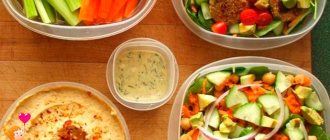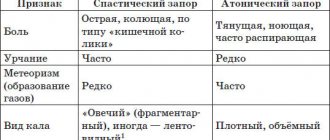Medical editor: Zemereva N.Yu., physiotherapist
Flatulence is a condition when gas formation in the intestines is increased, and the removal of gases from it is difficult. Due to increased gas production, the abdomen “swells”, which leads to pain.
Flatulence, as a rule, is only one of the symptoms of diseases of the gastrointestinal tract, so it is necessary to find out the cause of its occurrence. However, in many cases, following a diet helps to neutralize the manifestations of this pathology.
Basic Rules
The objectives of the diet for flatulence are:
- providing adequate nutrition;
- normalization of intestinal motor function;
- reducing the processes of inflammation, fermentation and putrefaction in the colon;
- exclusion of foods to which the patient has food intolerance;
- restoration of normal intestinal microflora.
First of all, therapeutic nutrition is aimed at combating putrefactive and fermentative diarrhea, during which gas formation increases.
According to the classification of treatment tables according to Pevzner, the diet for flatulence corresponds to table No. 5. But in each case, therapeutic nutrition is prescribed individually, taking into account the physiological characteristics of the patient and the presence of concomitant diseases of the digestive tract.
Daily nutrient content in the diet for flatulence:
- proteins – 110-120g
- fats – 50g;
- carbohydrates – up to 200g, especially limit simple sugars.
The energy value of the diet is reduced and amounts to 1600 kilocalories.
Principles of nutrition for flatulence:
Rules for eating
- Each meal should take place in a calm environment, snacking “on the run” is excluded. Food must be chewed thoroughly and not talking while eating: this prevents, firstly, swallowing air (aerophagia), and, secondly, reduces the load on the digestive tract.
- In addition, if you have flatulence, it is not recommended to drink during meals.
- You should also observe the hours of eating, this sets the gastrointestinal tract to work harder at certain times and prevents the production of gastric juice, pancreatic enzymes and bile acids at inopportune hours, preventing the development of complications in the gastrointestinal tract.
- It is worth giving up chewing gum: it causes aerophagia and increases the secretion of gastric juice.
Regime: Meals should be fractional, up to 5-6 times a day, in small portions. Due to frequent meals, nutrients are promptly broken down in the intestines and absorbed, and residual dietary fiber is immediately evacuated, which prevents their rotting and fermentation.
Temperature of food: Food should be served warm, hot and cold foods should be avoided as they increase the secretion of stomach and pancreatic juices, which contributes to intestinal irritation.
Combination of products: It is necessary to have an understanding of mutually exclusive products (salty and sweet, vegetable fiber and milk). Their combined use leads to increased load on the digestive tract, increased intestinal motility, and also the occurrence of fermentation processes.
Culinary treatment: Therapeutic nutrition for flatulence is designed to provide mechanical and chemical sparing of the gastrointestinal tract. Therefore, dishes are served boiled, stewed, baked or steamed.
Salt and liquid: The content of table salt in dishes is somewhat limited: up to 6-8 grams, so as not to irritate the stomach and intestines. Fluid consumption should reach at least two liters per day: this ensures timely evacuation of feces, preventing fermentation.
Comments from nutritionists
In case of intestinal bloating and severe persistent flatulence, you should definitely undergo a gastrointestinal examination, since increased gas formation can be due to various reasons, and the correction of this condition must be individual. It should be understood that a diet for flatulence and bloating will be effective only if the cause (diagnosis) is established and the underlying disease is treated. For example, in case of lactase deficiency , a low-lactose or lactose-free diet is prescribed with the exclusion of milk sugar from the diet.
Diet therapy must necessarily be accompanied by correction of intestinal microbiocenosis by prescribing probiotics , for example, fermented milk probiotic products “Activia”, which help restore metabolic activity and the composition of intestinal microflora, as well as normalize intestinal motility. If necessary, symptomatic treatment is prescribed. simethicone are often prescribed as an additional means to alleviate the patient’s condition and eliminate flatulence, which significantly increases the effectiveness of diet therapy.
Prohibited Products
The list of prohibited products for flatulence primarily includes those that increase gas formation. They are divided into three groups.
The first group is plant coarse fiber, which serves as a food substrate for intestinal microflora, enhances its growth and, accordingly, the activity of bacteria, which promotes fermentation and the formation of gases.
The second group includes simple carbohydrates, which are easily broken down in the intestines and cause rotting of food masses.
The third group includes foods that the patient cannot tolerate. Most often, such intolerance is observed in relation to milk due to insufficient production of the enzyme - lactose.
It is recommended to exclude foods that stimulate intestinal motility due to their high content of carbon dioxide and organic acids.
Protein foods of animal origin, rich in connective tissue, also linger in the intestines for a long time, as a result of which fermentation of food masses increases.
In addition, you should avoid products that contain synthetic and natural irritants to the digestive tract (essential oils, preservatives, organic acids, food additives).
The list of prohibited products includes:
- wheat and rye bread, baked goods, especially fresh;
- pasta, noodles, dumplings, dumplings, pies and other baked goods;
- fatty meats, fish and poultry, stringy meat;
- rich broths (they contain extractive substances);
- all types of sausages (due to the presence of stabilizers, flavor enhancers, soy and other additives);
- marinades and pickles;
- caviar, corned beef, salted fish, smoked meats;
- canned food;
- mushrooms in any form;
- whole milk and as part of dishes, fermented milk products (depending on tolerance);
- kvass, kumiss, beer (they contain yeast);
- carbonated drinks;
- animal fats (for example, lard, cream, sour cream, butter);
- cereals (millet, pearl barley, barley);
- legumes, any cabbage, radish, radish, raw onion, daikon, rutabaga;
- sweet fruits (apples, peaches, pears, melons, grapes) and dried fruits (raisins and prunes);
- jam, honey, chocolate;
- sauces and herbs;
- hard-boiled or fried eggs;
- nuts;
- coffee and cocoa with milk.
Symptoms of flatulence
Flatulence may be accompanied by pain in various parts of the abdomen, bloating, a feeling of fullness, and a false urge to defecate. The severity of the pain varies depending on the volume of gases, the degree of stretching of the intestinal walls due to the accumulation of gases. Doctors Pakhomovskaya and Venediktova in their work point out that “the intensity of abdominal pain depends not only on the amount of accumulated gases, but also on the level of the threshold of visceral pain sensitivity” (Pakhomovskaya N.L., Venediktova M.M., 2021, p. 34). This means that the reaction can be individual. Much depends on whether a person had colic in infancy. It is known that when they are present, functional pain occurs more often in adulthood.
Flatulence in adults may be accompanied by other manifestations:
- nausea;
- belching;
- bowel disorders;
- decreased appetite;
- irritability, etc.
Doctors conventionally divide flatulence into two variants of manifestation. In the first case, the main symptom is an increase in abdominal volume, that is, bloating. In this case, normal passage of gases does not occur due to spasm of the colon.
In the second option, the passage of gas is violent and frequent, and the pain is not expressed. Patients complain of a characteristic rumbling in the stomach, a feeling of “rolling” in the intestines.
Pain can occur in one area or throughout the entire abdomen. The local nature of the discomfort is associated with the accumulation of gases in a certain part of the intestine, usually in the area of the cecum. They are not necessarily associated with episodes of eating or exercise. Extraintestinal symptoms also rarely occur: burning in the chest, tachycardia, weakness, sleep disturbances.
Authorized Products
Therapeutic nutrition for flatulence primarily includes:
- products that do not stimulate gas formation;
- products that have a carminative effect.
In addition, it is necessary to eat dishes that move gently and slowly through the intestines, but do not linger in it, that is, they normalize stool and the passage of gases.
Considering the change in intestinal microflora towards the growth of putrefactive and fermentative bacteria, when preparing food it is necessary to use products that stimulate the growth of normal microorganisms. The diet should be rich in lipotropic substances that have a beneficial effect on bile and blood vessels, calcium, potassium, iron and vitamins.
The list of permitted products includes:
- dried bread, crackers made from wheat flour;
- lean meats and poultry (without skin) and steamed dishes made from them: meatballs, soufflé, steamed cutlets, meatballs;
- lean fish in whole boiled pieces or in the form of minced meat;
- low-fat weak meat and fish broths;
- pureed cottage cheese, curd soufflé, low-fat biokefir, yogurt, non-acidic sour cream (if tolerated);
- vegetables: potatoes, pumpkin, zucchini, beets, carrots;
- garden herbs: dill, parsley, as well as “dill water”;
- cumin, bay leaf;
- green tea, cocoa in water, decoctions of bird cherry, blueberry, rose hip;
- pureed and slimy porridges in water: rice, semolina, buckwheat, oatmeal;
- soft-boiled eggs and steamed protein omelettes.
Lifestyle change
In the treatment of flatulence, daily routine and healthy habits are important. It is necessary to increase the frequency of meals, up to 5-6 times a day. Breakfast should consist of cereals.
It is important that each meal is calm; there is no need to talk during lunch. Try to chew your food thoroughly and take your time—allow enough time for lunch and snacks during the day. You should also not eat food while lying down. It is better to avoid drinking drinks through a straw or sucking on caramel.
A sufficient amount of water is important in the fight against stool disorders and the formation of large amounts of gas. Researcher Shulpekova in her scientific work points out that “sufficient fluid intake is up to 2–2.5 l/day. helps soften feces and diffusion of gases into the bloodstream” (Shulpekova Yu. O., 2013, p. 57).
You can help yourself with a food diary. Record the foods you eat and your feelings in it. This way you can understand which foods make your symptoms worse.
Consequences of not following the diet
If the diet is neglected, flatulence becomes a constant companion of a person, which means that the normal intestinal microflora dies, and fermentative and putrefactive bacteria begin to become active, which release toxins in the process of vital activity.
Toxins, in turn, are absorbed into the blood and negatively affect not only the organs of the digestive tract (for example, the liver), but also the entire body.
A lack of healthy microflora will lead to hypovitaminosis, since many vitamins are synthesized by normal intestinal microorganisms (vitamin K, B vitamins).
Results and reviews
Following a diet can reduce the manifestations of flatulence, as evidenced by patient reviews. However, as practice shows, in the presence of any gastrointestinal diseases, diet alone is not enough.
- “... The problem with flatulence arose a long time ago, which is why I often had to avoid public events. I went to a gastroenterologist, I was examined and diagnosed with colitis. After 3 months of treatment and following a diet, I got rid of my problem”;
- “... Flatulence against the background of constant constipation is a common occurrence for me. Therefore, I am constantly on a diet both for constipation and flatulence. But while I’m on a diet, after 1-2 weeks everything returns to normal, as soon as I stop it, everything appears again. It’s probably necessary to see a doctor and switch to medications in addition to the diet.”
Why is there constant bloating?
If abdominal discomfort persists for a long time, then this is a serious reason to contact a therapist and gastroenterologist. Constant bloating is an alarming symptom, indicating the presence of pathology of the digestive system. Particular concern should be caused by the fact of malaise against the background of normalization of nutrition and the abandonment of bad eating habits.
In diseases of the digestive system, bloating is accompanied by a set of other symptoms: severe pain, weakness, nausea, heartburn, diarrhea or constipation.
Bibliography:
- Gaus, O. V. Nutrition management in irritable bowel syndrome / O. V. Gaus, M. A. Livzan, D. V. Popello // Experimental and clinical gastroenterology. – 2021. – No. 10(182). – pp. 112-122. – DOI 10.31146/1682-8658-ecg-182-10-112-122.
- Pilipenko, V. I. Possibilities of diet therapy and herbal medicine for irritable bowel syndrome / V. I. Pilipenko, V. A. Isakov // Effective pharmacotherapy. – 2012. – No. 27. – P. 16-21.
- Marchukova, A. Yu. Irritable bowel syndrome: the role of dietary nutrition in therapy / A. Yu. Marchukova // Tauride Medical and Biological Bulletin. – 2014. – T. 17. – No. 3. – P. 116-120.
- Instructions for use IMODIUM ® Express lyophilisate tablets // Reg. number P N016140/01 RF GRLS. — https://grls.rosminzdrav.ru/Grls_View_v2.aspx?routingGuid=fdbc42af-4580-4ecd-93d8-2e9a965c707a&t= (access date: 09/14/2021)
- Kuvaev Roman Olegovich, Yakovenko Emilia Prokhorovna, Nikonov Evgeniy Leonidovich, Zaitsev Sergey Vyacheslavovich, Pospelova Ekaterina Evgenievna, Krashenkova Anastasia Pavlovna Diet with a reduced content of fermentable oligo-, di-, monosaccharides and polyols in the treatment of patients with irritable bowel syndrome: basic principles and methodology of application // Nutrition issues. 2021. No. 6. URL: https://cyberleninka.ru/article/n/dieta-s-ponizhennym-soderzhaniem-ferme... (access date: 08/20/2021).
- Makarenko, E. V. Irritable bowel syndrome: dietary recommendations and principles of treatment / E. V. Makarenko // Bulletin of Vitebsk State Medical University. - 2021. - T. 16, No. 6. - P. 23-34.
- Andreev D.N., Zaborovsky A.V., Trukhmanov A.S., Maev I.V., Ivashkin V.T. The evolution of ideas about functional diseases of the gastrointestinal tract in the light of the Rome criteria IV revision (2016). Ros journal gastroenterol hepatol coloproctol 2017; 27(1):4-11 DOI: 10.22416/1382-4376-2017-27-1-4-11
- Abdominal pain and visceral hypersensitivity in patients with irritable bowel syndrome. Rome criteria IV and clinical practice / Ardatskaya M.D., Topchiy T.B. – M.: Prima-Print, 2021. – 63 p.: ill. – ISBN 978-5-9907557-9-6.
- Ivashkin V.T., Shelygin Yu.A., Baranskaya E.K., Belousova E.A., Beniashvili A.G., Vasiliev S.V., Golovenko A.O., Golovenko O.V., Grigoriev E. L.G., Kostenko N.V., Lapina T.L., Loranskaya I.D., Lyashenko O.S., Maev I.V., Poluektova E.A., Rumyantsev V.G., Timerbulatov V.M. ., Trukhmanov A.S., Fomenko O.Yu., Khalif I.L., Chashkova E.Yu., Sheptulin A.A., Shifrin O.S., Yanovoy V.V. Clinical recommendations of the Russian Gastroenterological Association and the Association of Coloproctologists of Russia for the diagnosis and treatment of irritable bowel syndrome. Ros journal gastroenterol hepatol coloproctol 2017; 27(5):76-93 DOI: 10.22416/1382-4376-2017-27-5-76-93
- Global practical recommendations of the World Gastroenterological Organization. Celiac disease. 2021.
- Bakulina I.G., Avalueva Elena Borisovna, Oreshko Lyudmila Savarbekovna, Sitkin Stanislav Igorevich, Shevyakov Mikhail Alexandrovich, Serkova Margarita Yurievna, Semenova Elena Anatolyevna. DIETOTHERAPY FOR IRRITABLE BOWEL SYNDROME // Therapeutic Archives, T. 92, No. 8, 2021, pp. 118-127.
- GBUZ "Moscow Clinical Scientific and Practical Center named after A.S. Login of the Moscow Department of Health." Methodological recommendations (diagnosis and treatment) Irritable bowel syndrome, Moscow, 2021, 22 p.
- Practical recommendations of the World Gastroenterological Organization. Diet and intestines. 2018
- Global practical recommendations of the World Gastroenterological Organization. Management of common gastrointestinal symptoms in the general population. Global Look at Heartburn, Constipation, Flatulence and Abdominal Pain/Discomfort 2013
- A study by Ameri et al. "A multicenter, double-blind study: a comparison of the effectiveness of loperamide in acute diarrhea with two popular antidiarrheal agents and placebo," 1975.
Preventing bloating
Normalizing your diet and healthy lifestyle will help you avoid attacks of flatulence (Fig. 4).
Basic principles of prevention:
- eat often, but in small portions;
- pay attention to physical activity;
- monitor your weight;
- give up carbonated drinks;
- do not chew gum or eat on the go;
- drink more plain clean water;
- include fermented milk products with prebiotics in your diet;
- Keep a food diary to find out which foods cause bloating.
Figure 4. Prevention of flatulence.
What to do if you have bloating
You can alleviate the condition of bloating by taking certain medications, but taking them without consulting a doctor, relying only on advertising, is very dangerous. If you have abdominal pain, you can take antispasmodics, but it is best to give up junk food for a while and lie down quietly.
When should you go to the doctor?
Check with your doctor if bloating is accompanied by any of the following symptoms:
- severe or prolonged abdominal pain;
- blood in the stool or dark, tarry stool;
- heat;
- diarrhea;
- worsening heartburn;
- vomit;
- asymmetrical abdominal enlargement;
- unexplained weight loss.
If the condition is not acute and does not allow you to leave the house, you should call an ambulance. Bloating may be a sign of acute appendicitis or intestinal obstruction, these conditions require urgent medical attention.
Signs that bloating is caused by a serious problem
Sometimes, based on symptoms, you can suspect a possible cause of bloating:
- Pain and bloating after eating foods made from rye, wheat or barley may indicate celiac disease, a disease associated with gluten intolerance.
- Bloating followed by constipation or diarrhea may mean a person is suffering from irritable bowel syndrome.
- Pain in the right lower abdomen may indicate appendicitis.
- Bloating after eating certain foods can be a sign of a food allergy.
- Painful bloating along with a feeling of nausea may be associated with cholelithiasis.
- In women, bloating and menstrual irregularities may be symptoms of ovarian cancer.
- Pain and bloating when the stomach is empty may indicate ulcers.
